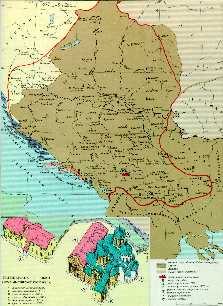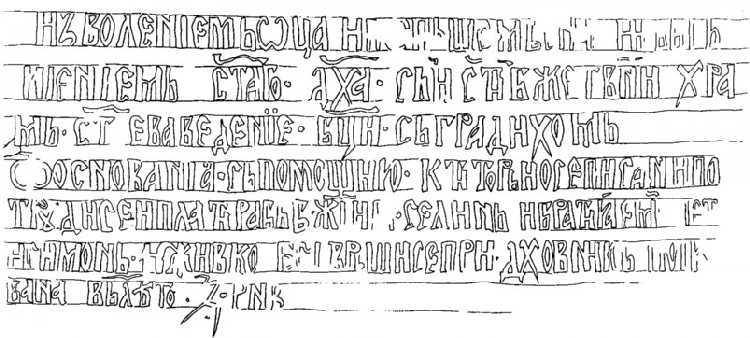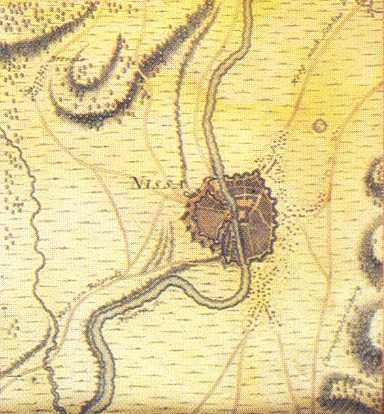
From the first decades of the occupation, the acts of the Ohrid Synod of 1528 and 1532 contain the signature of the metropolitan of Niš Matej. We also know the name of "the bishop of Niš and Leskovac" Jeftimije for the year 1592.
The jurisdiction of the Patriarchate of Peć, ca 1660
During the long-lasting Turkish occupation, the Serbian people, headed by the Church, adapted to the new circumstances. The Church took the responsibility for preserving not only the population, but the cultural and historical heritage as well. The spiritual and intellectual elite withdrew to the surrounding villages, looking for protection. In secluded monasteries, humble monks started the fight for the preservation of cultural and national identity of the Serbian people. The atmosphere is best described in the note found on the margins of a book written in the Monastery of St. John, above Gornji Matejevac, in 1597, from which we learned the name of the bishop of Niš region, Georgije.
In these difficult times, when the Osmanli power was at its peak and the Serbian people started struggling against the heterodox authorities, the educational, cultural and building activities had not died out. In 1509, in the temple of St. Nicholas of the Monastery of Železnik near Miljkovac, a Menaion was written. In the Monastery of St. George above the village Kamenica, dating from the second half of the 15th century, mentioned as the biggest in the Turkish registers of 1498, books were not only copied but illustrated as well. In the 16th century, the Monastery represented an important center of scribes and illuminators. The books, written and decorated here by the hierodeacon Arsenije in 1515 and 1553, during the administration of Prior Grigorije and Senior Monk Leontije, reached the Monastery Šišatovac, probably along with the people running away from these parts because of the Turkish oppression. The Monastery of St. George became a center of spiritual and cultural life of Serbs in that period. Niš was also known as an educational center in the first half of the 16th century, which is confirmed by the fact that Petar Gramatik, an outstanding mid-century gospel transcriber from Kruševac, was educated in this town. That was the period when the institution of senior monks, headed by Senior Monk Leontije, was very strong in Niš, as a heritage from the times of Serbian statehood.
Upon the restoration of the Patriarchate in Peć, in 1557, the Metropolitan Diocese of Niš took an important position in the history of the Serbian Church. There are only a few preserved monuments from this post-Byzantine period in Niš. Evident remnants of sacral buildings in the immediate surroundings of Niš point out a climate more favorable than the one in Niš. During the Turkish occupation, the town of Niš was either ruined or inhabited by Turkish majority. In any case, the vicinity of Niš had a lot of well-cultivated villages that offered "pleasant sojourn". In the first half of the 17th century, those villages experienced certain economical progress and achieved material stability that enabled the Christian population to develop their cultural and spiritual life.
Patriarch Pajsije managed by his wise policy and correct attitude towards our cultural heritage to create the atmosphere of unexpected enthusiasm in building and decorating temples.

Monastery of St. Mother of God in the Sićevo Klisura Gorge
The inscription about the Church building and frescoing
At that time, Sićevo belonged to the Serbian Patriarchate, according to the registers of the church office from 1640-1655. There are no reliable data concerning the head of the Niš Eparchy then. The mentioning of the bishop of Niš Region Macarius is not dated. In the mid 17th century, the Niš Eparchy was headed by the bishop of Niš Gerasim, whose signature was found on the margins of a book from 1645, now kept in the Chilandar Monastery.
During the long-lasting heterodox occupation, the Church of St. Nicholas used to be the only Orthodox temple in the town. The Church of St. Nicholas suffered serious damages in 1690, together with the people who had joined Austrians the previous year in expelling the Turks and did not withdraw with Arsenije III Čarnojević. In those hard times, the Niš Eparchy was headed by bishop Ruvim (1680-1707), the bishop of Niš and Leskovac, as he signed in 1689 in the Monastery of Cetinje.

The map of Niš from 1730
The period of peace did not last for long. Already in 1737, Serbian people again joined Austrians in their fight against the Turks, and the Metropolitan of Niš Georgije Popović took particularly active part in it. These days, Patriarch Arsenije IV Jovanović stayed in the Church of St. Nicholas. Soon after that, the Turks recaptured Niš, and the population withdrew with Arsenije IV, in fright of revenge. The Metropolitan of Niš found shelter in Matejevac during the war. Upon the surrendering of Niš to the Turks and the withdrawal of the Austrians in 1737, the Church of St. Nicholas was transformed into a mosque the very next year. The Metropolitan of Niš had to perform religious service in the village of Matejevac during these troublesome times, but we do not know in which of the Matejevac temples he resided. Yet, the Monastery of St. John, secluded and with a strong tradition, might have been a center of the spiritual elite who fled from the Turkish vengeance, as it had already been before, at the end of the 16th century.